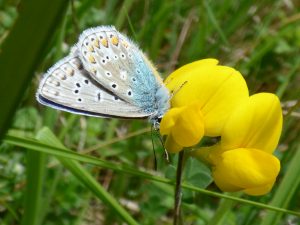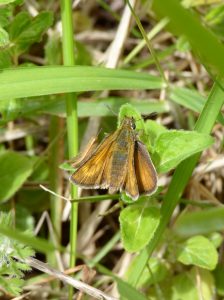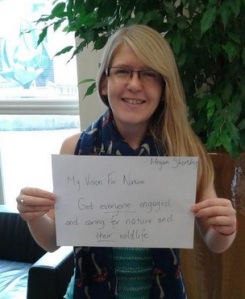Day Two of Megan & Matt Go Wild!
Welcome to our joint-blogging series for the Wildlife Trusts’ 30 Days Wild Challenge – you can read more about the campaign and ourselves in our introduction page.
(Matt, at a conference in Germany)
It’s a wet and dreary day in Bonn, but as I left my hotel at 7.10 this morning I took a scenic route through the park next to the U-Bahn (the overground train system). The gentle dripping of the rain through the trees’ foliage calmed my mind as it whirred with the previous day’s climate negotiations and the tasks for the day ahead.
I paused for a moment to watch a mistle thrush pulling a worm from the sodden earth, and felt reconnected with the birds and the global web of life that’s the reason I’m here in Germany to fight for a safe and stable climate.
(Megan, in coastal Dorset)
I had a much earlier start than usual for Day 2 of 30 Days Wild. Not as early as a dawn chorus walk, but earlier enough for me to be sleepy mid-afternoon! I had kindly been invited over to the neighbouring town of Dorchester by BBC Dorset to be interviewed on the nesting kestrels at Lorton Meadows Nature Reserve (which is [a] owned/managed by Dorset Wildlife Trust, and [b] one of my work locations – the other being the Chesil Beach Centre).
If you’ve been following my weekly blog posts, you will know the story already. For those new to the drama – the previous female was killed just 6 days before the eggs were due to hatch. Luckily, a new female appeared one the scene and has paired up with the male. I stitched together a video of them, just before their first egg was lain. At the time of the interview, there were 4 eggs. At the time of writing, there are now 5! You can watching the nestbox online via the webcam.
It was fantastic to have this opportunity to talk about wildlife to a different audience. I found it quite nerve-wracking but the BBC staff were brilliant at putting me at ease, and the wonderful Sally (Communications Officer for Dorset Wildlife Trust) came along for moral support. I have since listened back at the recording – it is very odd to listen to my own voice!












































































































































































































